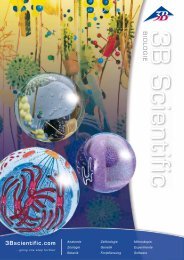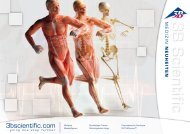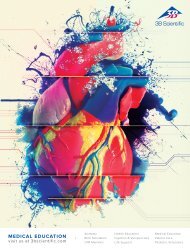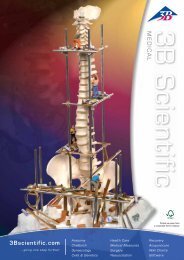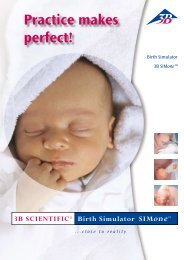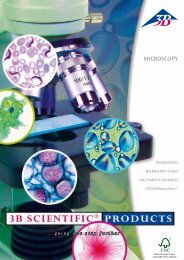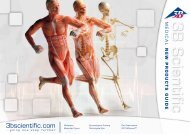3B Scientific - Biology Catalog
3Bscientific.com
3Bscientific.com
You also want an ePaper? Increase the reach of your titles
YUMPU automatically turns print PDFs into web optimized ePapers that Google loves.
Reproduction and Sex Instruction<br />
Reproduction serves for the preservation of the species. The number of germ cells must balance losses<br />
caused by environmental factors (predators, climate, catastrophes), so that the number of reproductive<br />
individuals remains constant within certain parameters. The CD provides a vivid introduction<br />
into the biology of reproduction from unicellular organisms through to mammals, providing detailed<br />
representations of human reproduction and furnishing other teaching material for sexual instruction.<br />
Sexual and asexual reproduction. Fertilization of the ovum and fusion of both haploid nuclei. The different<br />
types of egg cells and the corresponding types of cleavage. Gastrulation, neurulation, formation<br />
of germ layers. Examples of organ development. Structure and function of male and female sexual<br />
organs. Testis, epididymis, spermatogenesis, spermatozoa. Structure of the uterus wall. Menstruation<br />
cycle and fertilization. Changes in uterine lining (endometrium). Ovulation, admission of the ovum<br />
into the fallopian tube, fertilization, development in the fallopian tube and embedding in the endometrium.<br />
Growth of the foetus in the uterus. Embryonic and maternal circulation. Foetus in the<br />
uterus, placenta, umbilical cord, amnion. Developed foetus in the womb. Start of the birth process,<br />
entrance of the amniotic sac into the birthing canal and birth are described.<br />
9982-1004279<br />
Nervous System and Transmission of Information, Part I<br />
Introductory CD for the nervous system. View of the entire human nervous system. Occurrence of<br />
the typical nerve cells in the human nervous system. Fine structure of a neuron, composition of the<br />
nerve, motor end plates, glial cells, nerve cells and nerve tissue. Neuron, ganglion, centres, reflex<br />
arcs, automatism. Embryonic development of the human nervous system. Neural plate, neural<br />
groove, formation and closure of the neural tube. Description of the development of different nervous<br />
systems of invertebrates and vertebrates facilitates understanding of the human nervous system.<br />
Formation of the neopallium from concentric growth rings. Phylogenetic tree of mammalian brain<br />
convolutions. Connection between brain sensory and motor nerves and various body areas. Development<br />
of the thalamus into a relay station. Progressive concentration and differentiation in the brain,<br />
component parts and their relation to each other. Increase in organizational complexity.<br />
9982-1004280<br />
Nervous System and Transmission of Information, Part II<br />
The human central, peripheral and autonomic nervous system. Spinal cord: structure and function.<br />
Function of grey and white matter. Diagram of reflex connections. Examination of human reflexes<br />
and of diseases affecting the nervous system: polio, syphilis, sclerosis, paraplegia. Embryonic development<br />
and hierarchical structure of the brain. Structure and function of brain stem, cerebrum and<br />
cerebellum. Course of typical sensory and motor tracts. Perception, conduction and transmission of<br />
information. Conscious and unconscious movement controls. The brain is simultaneously connecting<br />
and controlling organ: for that reason, information perception, conduction and transmission are<br />
treated in a special section: resting potential at the axon sheath and its change. Transmission of information<br />
over the synaptic gap. Types of synapse. Stimulus propagation along the axon. The brain’s<br />
blood supply: as the controlling organ of our body is the brain the biggest consumer of energy. The<br />
blood-brain barrier. Brain stem, hindbrain and cerebellum. Brain lesions (diving accident, stroke). The<br />
autonomic nervous system, antagonistic effect between the sympathetic and parasympathetic part.<br />
Regulation of body temperature. Control of the emptying of the urinary bladder, transmitter and inhibiting<br />
substances at synapses and motor end plates.<br />
9982-1004281<br />
Software<br />
Heredity and Genetics of Man, Part I<br />
The basis of both CD’s in this series is the range of newest findings in the field of human genetics. As<br />
an introduction, the basic knowledge on formal genetics is first imparted, illustrated and explained<br />
using many examples from medical genetics. Detailed description of hereditary transmission: Autosomal<br />
dominant inheritance, autosomal recessive mode of inheritance, X-chromosomal inheritance,<br />
multifactorial and mitochondrial inheritance. Part 2 shows the different types of human tissue cultures,<br />
sex chromatin in both normal and pathological numbers of gonosomes through the analysis of<br />
Barr bodies, drumsticks and F-bodies. Analysis of metaphase chromosomes by various banding techniques.<br />
Chromosomal aberrations and their phenotypic consequences. Secondary chromosomal aberrations<br />
following exposure to clastogens and repair defects. Examples from tumour cytogenetics.<br />
9982-1004283<br />
168 <strong>3B</strong> <strong>Scientific</strong>® <strong>Biology</strong>




